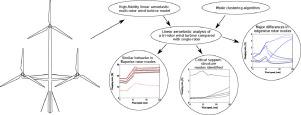International Journal of Mechanical Sciences ( IF 7.3 ) Pub Date : 2021-05-16 , DOI: 10.1016/j.ijmecsci.2021.106525 Oliver Tierdad Filsoof , Anders Yde , Peter Bøttcher , Xuping Zhang

|
This paper presents the first investigation on a high-fidelity linear time-invariant aeroelastic model of multi-rotor wind turbines with three-bladed rotors. The modeling method developed in this work integrates the rotor model from the aeroelastic single-rotor wind turbine stability software HAWCStab2 with a model of the support structure in the aeroelastic multi-body tool HAWC2.
The method is used to analyze the linear aeroelastic response of the DTU 30 MW tri-rotor wind turbine to see if the system experiences any aeroelastic instabilities or has any critical low damped modes. Furthermore, a comprehensive aeroelastic analysis of the DTU 10 MW wind turbine is performed and used to compare rotor modes between the two types of wind turbines. The results from the aeroelastic analysis are visualized using a developed mode-clustering algorithm utilizing an extension of the modal assurance criterion.
The results show that the tri-rotor wind turbine does not have any aeroelastic instabilities. Comparing the rotor modes of the single-rotor and the tri-rotor wind turbine shows that the dynamics of the lower rotors change significantly both in natural frequencies and damping ratios. This means that it can be sub-optimal to use the rotor from a single-rotor on a multi-rotor configuration. It is found that for multi-rotor wind turbines with arm structures the vertical arm-bending modes are low damped and therefore at risk of aeroelastic instabilities in addition to the side-side tower modes.
The aeroelastic multi-rotor wind turbine modeling framework is verified by comparing frequency response functions with a nonlinear model in HAWC2.
中文翻译:

三旋翼风力机临界气弹模态研究
本文首次研究了具有三叶转子的多转子风力涡轮机的高保真线性时不变气动弹性模型。在这项工作中开发的建模方法将来自气动弹性单转子风力涡轮机稳定性软件 HAWCStab2 的转子模型与气动弹性多体工具 HAWC2 中的支撑结构模型相结合。
该方法用于分析 DTU 30 MW 三转子风力涡轮机的线性气动弹性响应,以查看系统是否遇到任何气动弹性不稳定性或是否具有任何临界低阻尼模式。此外,还对 DTU 10 MW 风力涡轮机进行了全面的气动弹性分析,并将其用于比较两种风力涡轮机之间的转子模式。气动弹性分析的结果使用开发的模式聚类算法可视化,该算法利用模态保证标准的扩展。
结果表明,三旋翼风力机不存在任何气动弹性不稳定性。比较单旋翼和三旋翼风力机的转子模式表明,下转子的动力学在固有频率和阻尼比方面都发生了显着变化。这意味着在多转子配置上使用来自单转子的转子可能是次优的。研究发现,对于具有臂结构的多转子风力涡轮机,垂直臂弯曲模式是低阻尼的,因此除了侧塔模式之外还有气动弹性不稳定性的风险。
通过将频率响应函数与 HAWC2 中的非线性模型进行比较,验证了气动弹性多转子风力涡轮机建模框架。



























 京公网安备 11010802027423号
京公网安备 11010802027423号